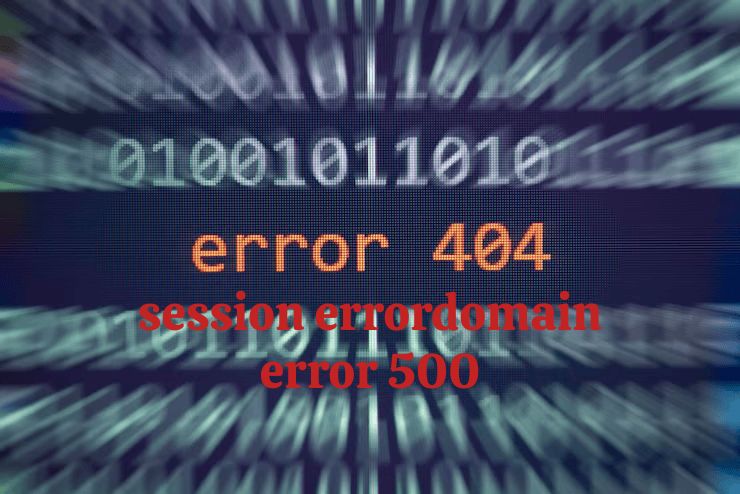
Have you ever encountered the dreaded session errordomain error 500 while browsing the web or using an app? If so, you’re not alone! This perplexing error can be frustrating, leaving users scratching their heads and developers scrambling for solutions. But fear not, for we’re here to shed some light on this enigmatic error and provide you with the knowledge you need to tackle it head-on!
Table of Contents
Demystifying Session Errordomain Error 500
Session errordomain error 500, often simply referred to as “error 500,” is a common HTTP status code that indicates an internal server error. It’s like the Bermuda Triangle of the digital world—mysterious, perplexing, and sometimes downright frustrating! But what exactly does it mean, and why does it occur? Let’s dive deeper into the abyss and unravel the mysteries of error 500!
What Causes Session Errordomain Error 500?
The causes of session errordomain error 500 can be as diverse as the digital landscape itself. Here are some common culprits:
- Server Misconfigurations: Sometimes, the server responsible for processing your request gets confused or encounters an unexpected configuration issue, leading to error 500.
- Programming Errors: Ah, the joys of coding! A simple typo or logic error in the server-side script can wreak havoc and trigger error 500.
- Resource Exhaustion: When the server is overwhelmed with requests or runs out of resources like memory or disk space, it may throw its hands up in despair and serve you with error 500.
- Database Issues: If the server relies on a database to fulfill requests, any issues with the database, such as connection failures or query errors, can result in error 500.
The Implications of Error 500
Now that we’ve identified some potential causes of session errordomain error 500, let’s explore its implications. What does it mean for users, developers, and the digital ecosystem as a whole? Understanding these implications is crucial as it allows us to grasp the broader impact of error 500 and devise effective strategies for mitigation and resolution.
- User Frustration: For users, encountering error 500 can be a major buzzkill, especially if they’re in the middle of a crucial task or transaction. It’s like getting stuck in traffic when you’re already late for an important meeting—not fun!
- Reputation Damage: From a developer’s perspective, error 500 isn’t just an inconvenience—it can also tarnish their reputation. Users may perceive frequent errors as a sign of incompetence or unreliability, leading to loss of trust and loyalty.
- Lost Revenue: If error 500 occurs during a transaction, such as an online purchase or payment processing, it can result in lost revenue for businesses. Imagine having your credit card declined at the checkout counter—ouch!
How to Resolve Error 500
Now for the million-dollar question: How do you fix session errordomain error 500 and restore order to the digital universe? Fear not, brave soul, for we’ve compiled a handy list of tips and tricks to help you banish error 500 once and for all! From double-checking your server configurations to seeking assistance from online communities, we’ve got you covered every step of the way!
- Check Server Logs: The first step in troubleshooting error 500 is to check the server logs for any clues. These logs can provide valuable insights into what went wrong and where to start looking for a solution.
- Review Recent Changes: Did you recently make any updates or changes to your website or app? If so, they could be the culprit behind error 500. Roll back any recent changes and see if the error persists.
- Test with Different Browsers and Devices: Sometimes, error 500 may be specific to certain browsers or devices. Try accessing your website or app from different browsers and devices to see if the error is consistent.
- Consult the Experts: If all else fails, don’t hesitate to reach out to the experts for help. Whether it’s your hosting provider, a seasoned developer, or an online community, there’s a wealth of knowledge and support available to help you troubleshoot error 500.
FAQs: Your Burning Questions Answered!
Q: Is session errordomain error 500 always the server’s fault? A: Not necessarily! While error 500 is often caused by server-side issues, it can also be triggered by client-side factors such as invalid input or network connectivity problems.
Q: Can error 500 be fixed without technical expertise? A: In some cases, yes. Simple fixes like clearing your browser cache or restarting your device may resolve error 500. However, for more complex issues, technical expertise may be required.
Q: How common is error 500? A: Error 500 is fairly common in the digital realm, affecting websites, apps, and online services of all shapes and sizes. It’s like the common cold of the internet—annoying but usually harmless.
Conclusion: Conquering Error 500, One Session at a Time!
In conclusion, session errordomain error 500 may seem like a formidable foe, but with the right knowledge and resources, it can be tamed! By understanding its causes, implications, and potential solutions, you’ll be better equipped to navigate the digital landscape and keep error 500 at bay. So fear not, intrepid explorer, for you now possess the tools to conquer error 500 and emerge victorious on your digital journey!







